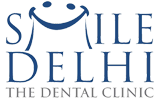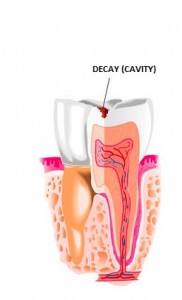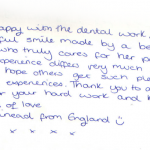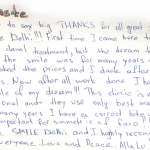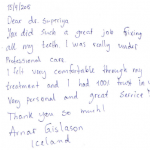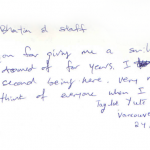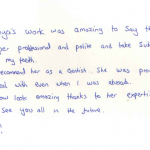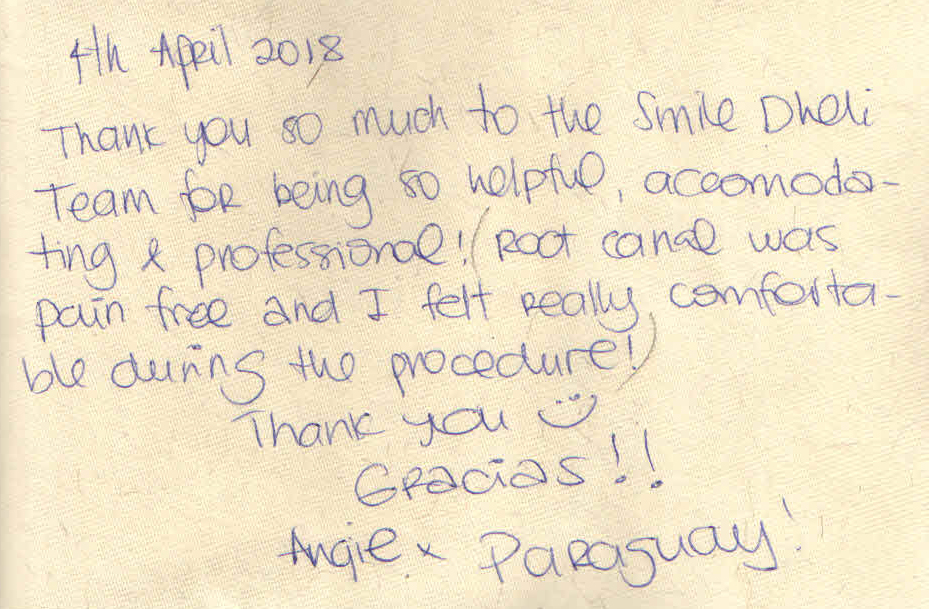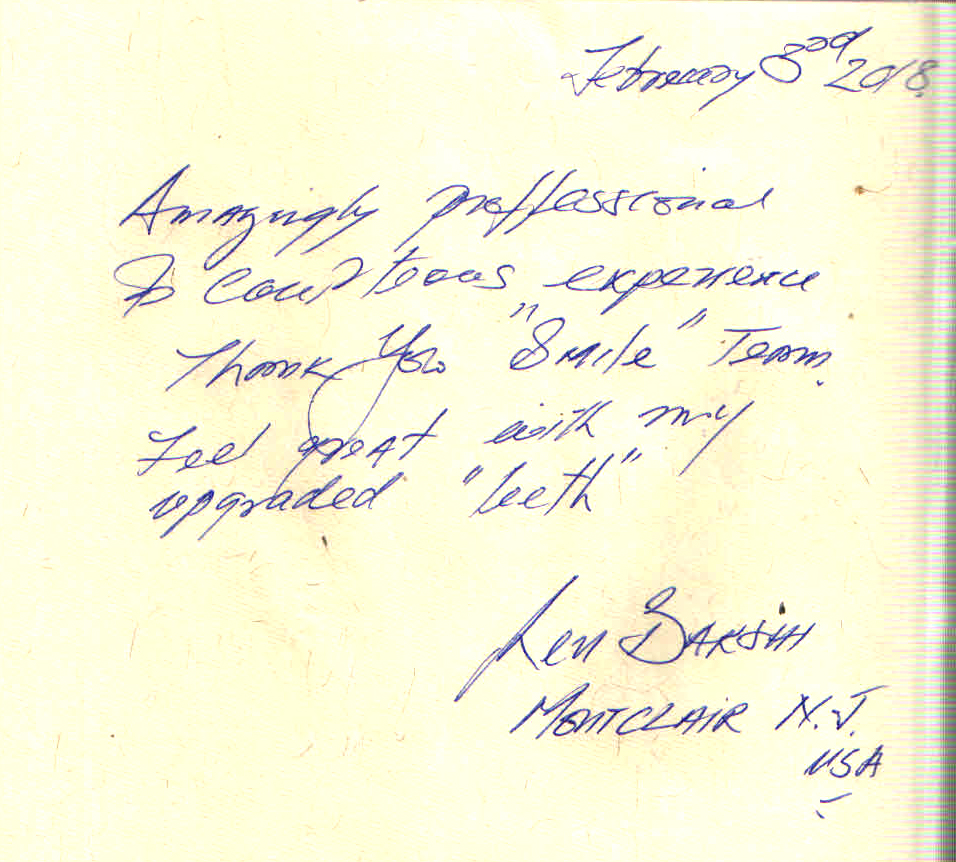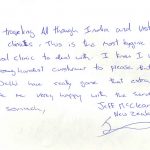Tooth Decay: Symptoms, Treatment, and Prevention
Tooth decay is a common disorder, second only to the common cold . Tooth decay is the damage that occurs as a result of an infection with certain types of bacteria that use sugars or starch(such as milk, bread, cookies, candy, soda, juice, and many others ) in food or drink to produce acids in your mouth that eat away at a tooth.
Throughout the day, a war takes place inside our mouths.
Our mouths are full of bacteria. Hundreds of different types live on our teeth, gums, tongue and other places in our mouths. Some bacteria are helpful but some can be harmful such as those that play a role in the tooth decay process. Bacteria and food can cause tooth decay.
Plaque, a clear, sticky film of bacteria is always forming on your teeth and gums. Plaque contains bacteria that feed particularly on sugary foods and drinks when you consume food and drink high in carbohydrates.
Carbohydrates (sugars and starches) increase the risk of tooth decay. Sticky foods are more harmful than non-sticky foods because they remain on the teeth.
The bacteria in plaque turn the carbohydrates into energy they need, producing acid at the same time. The stickiness of the plaque keeps these acids in contact with your teeth and over time, these repeated cycles of acid attacks begin to eat away at the tooth’s hard outer surface or enamel as it continues to lose minerals.
A chalky white spot may appear where minerals have been lost. This is a sign of early decay. Tooth decay can be stopped or reversed at this point. There are also some minerals in our saliva (such as calcium and phosphate) plus fluoride from toothpaste, water, and other sources. This team helps enamel repair itself by replacing minerals lost during an “acid attack.”
Our teeth go through this natural process of losing minerals and regaining minerals all day long.
A tooth has three layers. The hard outer layer is called enamel. The middle layer is called dentine. The centre of the tooth is called the pulp.
It contains nerves and blood vessels.
Over time, if the plaque is allowed to build up, the acid can continue to break down (dissolve) the surface of your tooth, the tooth enamel is weakened and destroyed; forming a cavity. Once a cavity forms, the lost tooth structure cannot be regenerated.
Once cavities have formed in the enamel, the plaque and bacteria can reach the dentine (the softer, bone-like material underneath the enamel), the process of tooth decay speeds up.
Without treatment, bacteria will enter the pulp (the soft centre of the tooth that contains nerves and blood vessels). Cavities usually do not hurt, unless they grow very large and affect nerves or cause a tooth fracture. At this stage, your nerves will be exposed to bacteria, usually making your tooth painful and temporarily worsening with exposure to heat, cold, or sweet foods and drinks. A tooth weakened by extensive internal decay can sometimes suddenly fracture under normal chewing forces.
The more layers that are affected by decay, the worse the damage. A cavity or hole in the tooth is permanent structural damage that a dentist has to repair with a filling. It usually occurs in children and young adults, but can affect any person.
If not treated, the bacteria can cause a dental abscess in the pulp and the infection could spread into the bone, causing another type of abscess and can cause pain, infection, and tooth loss. Tooth decay is a common cause of tooth loss in younger people.
Cavities are more common among children, but changes that occur with ageing make cavities an adult problem, too. Recession of the gums away from the teeth, combined with an increased incidence of gum disease, can expose tooth roots to plaque. Tooth roots are covered with cementum, a softer tissue than enamel. They are susceptible to decay and are more sensitive to touch and to hot and cold. It’s common for people over age 50 to have tooth-root decay.
Decay around the edges, or a margin, of fillings is also common for older adults. Because many older adults lacked benefits of fluoride and modern preventive dental care when they were growing up, they often have a number of dental fillings. Over the years, these fillings may weaken and tend to fracture and leak around the edges. Bacteria accumulate in these tiny crevices causing acid to build up which leads to decay. Dentists in dental clinics in Delhi and India are following a systematic protocol of 6 monthly reminders for patients to come for regular dental check ups so that a cavity can be detected and treated at an incipient stage.
What are the symptoms?
Tooth decay may not cause any pain until you have a cavity or an infected tooth. However, if you have dental decay you might have:
- Grey, brown or black spots or pits appearing on your teeth.
- Tooth sensitivity – you may feel tenderness or pain when eating or drinking something hot, cold or sweet.
- Discomfort or toothache, either continuous pain keeping you awake or occasional sharp pain.
- Inability to bite down on tooth.
- Swelling in your gums around a sore tooth. This can be a sign of severe tooth decay or an abscessed tooth
- Bad breath or a bad taste in your mouth.
If you have a toothache, see a dentist. Sometimes the pain will go away for a while, but the tooth decay will keep growing. If you don’t get treatment, your cavities could get worse and your tooth could die.
What causes tooth decay?
Things that make you more likely to have tooth decay include:
- Not brushing and flossing your teeth regularly and not seeing a dentist for check-ups and cleaning’s.
- Eating foods that are high in sugar and other carbohydrates, which feed the bacteria in your mouth. Frequent snacking increases the time that acids are in contact with the surface of the tooth. The repeated acid attacks causing the tooth to lose minerals and eventually develop a cavity.
- Not getting enough fluoride. Fluoride helps prevent tooth decay by making teeth more resistant to acids produced by plaque. Fluoride is added to many public water supplies.
- Not having enough saliva. Saliva washes away food and harmful sugars, so it helps protect your teeth from decay. A dry mouth may be caused by a condition such as xerostomia or Sjögren’s syndrome, by taking certain medicines, or by breathing through your mouth. Older adults are more likely to have a dry mouth.
- Having diabetes.
- Smoking, using spit (smokeless) tobacco, or breathing second-hand smoke.
- Children, whose teeth are still growing, are more likely than adults to have tooth decay. This is because the minerals in new teeth are not very strong and are easier for acids to eat away.
- Even babies can be at risk for tooth decay. Babies who are put to bed with a bottle can get “bottle mouth -tooth decay caused by the sugar in milk, formula, or juice. Babies aren’t born with decay-causing bacteria in their mouths. But they can get bacteria from adults who share spoons, forks, or other utensils with them.
Dentist in Delhi and dentist in India are getting involved in counselling kids to take care of their teeth to prevent cavities. A proper regime for fluoride treatments for kids is being followed in the dental clinics in Delhi , in an endeavour to prevent cavities.
How is it treated?
Treatment can help prevent tooth damage from leading to cavities .The best treatment for tooth decay depends on how advanced and severe it is.
For early stage tooth decay –
- Visit your dentist so early tooth decay can be treated as soon as possible and the prevention of decay can begin. If tooth decay is caught early, before a cavity forms it is much easier and cheaper to treat. Your dentist will talk to you about the amount of sugar in your diet and the times you eat. You may be able to stop it by brushing with fluoride toothpaste or getting fluoride treatments. Fluoride is a mineral that can prevent tooth decay from progressing. It can even reverse, or stop, early tooth decay. It prevents mineral loss in tooth enamel and replaces lost minerals and reduces the ability of bacteria to make acid.
- They may apply a fluoride gel, varnish or paste to the area. Fluoride helps to protect teeth by strengthening the enamel, making teeth more resistant to the acids from plaque that can cause tooth decay. If the decay has eaten through the enamel, you may need one or more of these treatments:
Your dentist may discuss a filling or crown with you –
- This involves removing the dental decay. A filling if a cavity has formed. After the decay is removed, the dentist uses a material to fill the hole and restore the tooth to its original shape.
- A crown if the decay is severe and your tooth is badly damaged. A crown, or cap, is a man-made replacement for part of a tooth.
If tooth decay has spread to the pulp (in the centre of the tooth, containing blood and nerves) –
- This may be removed along with decayed portions of the tooth in a process known as root canal treatment. A root canal removes the diseased pulp of a tooth.
If the tooth is so badly damaged that it can’t be restored –
- It may need to be removed. Your dentist may be able to replace the tooth with a partial denture, crown or cap, bridge or implant.
How can you prevent tooth decay?
Oral hygiene is necessary to prevent tooth decay. It is often entirely preventable.
The best way to avoid tooth decay is to keep your teeth and gums as healthy as possible. You can prevent most tooth decay with these tips:
- Take good care of your teeth and gums. This consists of regular professional cleaning (every 6 months). Brushing your teeth twice a day, in the morning and before bedtime. Use fluoride toothpaste. Clean between your teeth with floss once a day. The primary focus of brushing and flossing is to remove and prevent the formation of plaque.
- Saliva flow decreases during sleep. Without enough saliva, teeth are less able to repair themselves after an acid attack.
- See your dentist for check-ups once or twice a year so problems can be found before they are serious based on the condition of your mouth, teeth and gums.
- Don’t snack before bedtime. Food left on the teeth overnight is more likely to cause cavities.
- Eat nutritious and balanced meals and Avoid or cut down foods and drinks that have a lot of sugar and starch, especially sugar-coated cereals, desserts, and sticky foods like candy and raisins. The longer sugar is in contact with your teeth, the more damage it will do as it creates a constant supply of acid in the mouth. If possible, brush the teeth or rinse the mouth with water after eating these foods.
- Avoid smoking or drinking alcohol excessively – tobacco can interfere with saliva production, which helps to keep your teeth clean, and alcohol can contribute to the erosion of tooth enamel.
- Dental sealants can prevent some cavities. Sealants are thin plastic-like coatings applied to the chewing surfaces of the back teeth (where decay often starts). The chewing surfaces of back teeth are rough and uneven because they have small pits and grooves. Food and bacteria can get stuck in the pits and grooves and stay there a long time because toothbrush bristles can’t easily brush them away. Sealants cover these surfaces and form a barrier that protects teeth and prevents food and bacteria from getting trapped there.
- Sealants are often applied on the teeth of children, to help protect child’s teeth from decay shortly after the molars come in. Older people may also benefit from the use of tooth sealants.
- Fluoride is often recommended to protect against dental caries. People who get fluoride in their drinking water or by taking fluoride supplements which strengthens your teeth have less tooth decay.
- Topical fluoride is also recommended to protect the surface of the teeth. This may include a fluoride toothpaste or mouthwash. Many dentists include application of topical fluoride solutions (applied to a localized area of the teeth) as part of routine visits.
- Our saliva can help fight off this acid attack, see your dentist if you have a persistently dry mouth –this may be caused by certain medicines, treatment or medical conditions.
- Protecting your child’s teeth
1- If you have children, get regular dental check-ups and cleaning’s to remove dental plaque, protect your child’s teeth and take steps early to prevent tooth decay.
2- Establishing good eating habits by limiting sugary snacks and drinks can help your child avoid tooth decay. Regular visits to the dentist at an early age should also be encouraged.
3- To help prevent baby bottle tooth decay, don’t put your baby to bed with a bottle of milk, formula, or juice.
4- To help prevent the spread of decay-causing bacteria, don’t feed your baby from utensils you have used.
5- Teach your children to brush their teeth in the morning and at night properly especially before bedtime and regularly.
6- Keep your children away from tobacco smoke.
Posted By – Dr. Shriya
